|
Types of Irrigation Systems
Landscape irrigation devices can be divided into two major types: point-source and spray. Spray irrigation is suitable for lawns and groundcovers. Drip irrigation is suitable for any tree, shrubs or perennial plants.
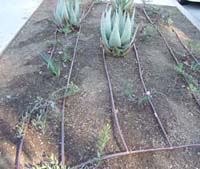
Drip irrigation
|
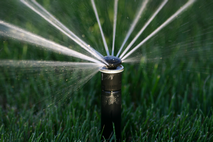
Sprayhead with rotary nozzle
|
What is Spray and Point-Source Irrigation?
Watering Device
|
Description
|
Radius of Water Spray
|
Spray Irrigation
|
Rotor / Impact
|
Sprinklers with one or more rotating streams of water for very large areas, like parks and large residential lawns.
|
15’ to 60’
|
Sprayhead
|
Sprinklers with a fan-shaped spray pattern. When installed with a Low Precipitation nozzle, it will use up to 30% less water and have a lower precipitation rate which increases the penetration of the water into hard soils.
|
5’ to 15’
|
Micro Irrigation
|
Microspray
|
A small spray emitting system with low precipitation and flow rates. Best used in shrub or perennial beds. Easy to assemble. Flow is measured in gallons per hour (gph).
|
4’ to 8’
|
Drip
|
A device that emits water slowly in drops 0.5 to 2 gallons per hour or more. The tubing can have emitters on it (on-line tubing) or inside (in-line tubing). Needs to have a pressure regulator and filter added to the valve.
|
N/A
|
Bubbler
|
Bubbler
|
Forms a fountain, small stream or tiny umbrella in the vicinity of the emitter. Good for trees. Install underground near tree roots (root zone watering system).
|
N/A
|
Drip Irrigation
| • | Drip irrigation will use ~80% less water than traditional sprinklers. |
| • | When designed and installed properly, drip is easy to maintain, doesn't produce overspray or runoff, and has fewer weeds in the garden. |
| • | Drip tubing is flexible tubing into which emitters (tiny water-flow regulators) are inserted. |
| • | In-line tubing is also flexible tubing, but it has emitters evenly spaced inside the tubing. Spacing of the emitters can be from 6" to 36". |
| • | Some drip lines may be placed on top of the ground with an emitter(s) at each plant, and covered by a few inches of mulch. |
| • | A subsurface drip line (underground) can be used to irrigate ground covers and lawn, but an experienced designer and installer is highly recommended in the case of lawns. Be very sure to install prior to installing the lawn. Installation can occur before (in ground) or after (above ground) for groundcovers. |
| • | Water is delivered just where plants need it. This can reduce the spread of weeds and help isolate them. |
| • | Water is applied very slowly in gallons per hour (gph). For clay soils 0.5 gph is suggested. |
| • | Drip must operate at reduced pressure to deliver small amounts of water. Low flow valves, pressure regulators, and filters are required. |
| • | Drip systems can be connected to a garden valve (hose bib) and operated manually or with a battery-powered controller. Drip can also be connected to your main water source with an anti-siphon valve and operated by an automatic controller. |
| • | Distribution tubing (1/4" tubing) is often used to reach plants that are a distance away from the main drip tubing line (e.g., 1-2'). A connector is used to attach the distribution tubing to the main line, and an emitter is inserted into the end of the distribution tubing next to the plant. To avoid having the ¼" tubing moved by people walking over it or raking the area, it should be pegged to the ground using barb stakes or simple metal "J" hooks. |
| • | Inspect plants regularly to be sure emitters are working properly and are not plugged or moved away from the plant. Sand and mineral deposits can plug the emitter and prevent water from flowing. Gophers can chew through distribution tubing, eliminating water to the plant and flooding other areas. |
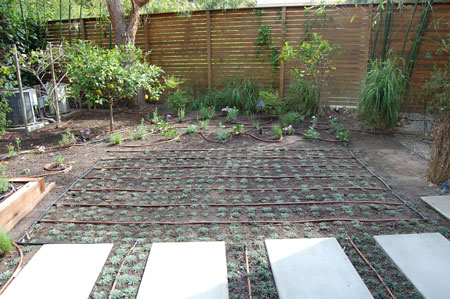
Drip irrigation using in-line 1/2" tubing
Spray Irrigation
| • | A traditional sprinkler system is about 50% efficient, which means you have to apply twice as much water to get even coverage. |
| • | Some spray irrigation systems emit water faster than the soil can absorb it causing runoff. This runoff picks up dirt and trash in the street as it flows to storm drains which are designed only for storm flow and not for excess irrigation runoff. Runoff is prohibited in most valley cities and is a major cause of water waste, groundwater pollution, and adds to the energy costs of providing water. |
| • | If installing new sprayheads, place them 24” away from any impermeable surfaces, like sidewalks and driveways. This may be required for some new landscapes, so check with your local building or planning department. |
| • | Spray irrigation is often installed in a way that it sprays a building foundation, exterior walls, fences, and benches, causing them to deteriorate quicker and require maintenance or replacement. |
| • | New low flow nozzles for sprinklers make traditional sprinklers more water-efficient and provide better water penetration reducing runoff. These matched-precipitation sprinkler heads guarantee that a half-circle head will deliver just as much water per square foot as a full-circle head spraying the same distance. Matched precipitation simply means all heads deliver a uniform amount of water across each square foot of an irrigated area. Every blade of grass gets no more and no less than the next. Ask for assistance from a knowledgeable salesperson. Matched precipitation heads are currently manufactured by: Rainbird, Hunter Industries, and Toro Irrigation. |
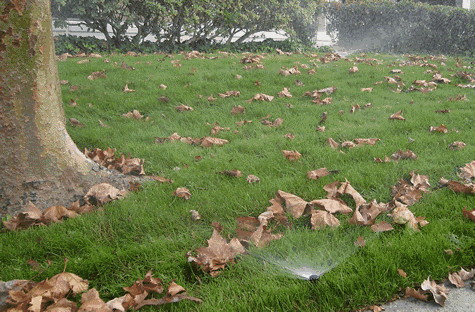
Fixed spray sprinklers.
Fixed spray, rotors, or impact sprinkler heads should be placed so water from one sprinkler head reaches adjacent sprinkler heads (head-to-head coverage).
Spray irrigation systems apply water in gallons per minute (gpm).
Sprinkler heads at the lowest point of a sloped area should be equipped with check valves. Check valves prevent run-off by not allowing the pipes to drain out of the lowest heads into the gutter and ultimately, into the storm drains, recharge basins, and even the river.
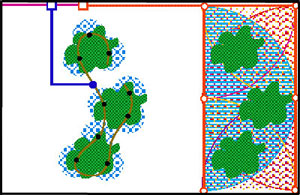
Drip Irrigation
Plant-Specific Coverage
|
Spray Irrigation
Area Coverage
|
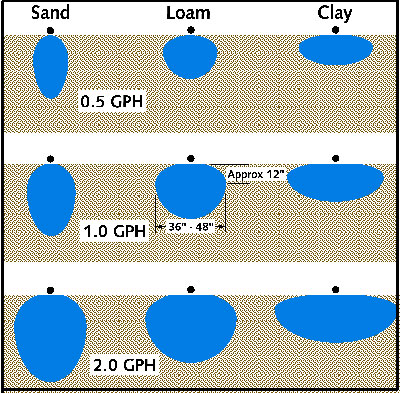
Wetting Patterns for Drippers in Various Soil Types (Idealized)
|
